Vinegar for black spots
I just received my Gardening Life magazine and noticed this recipe:
Acetic acid fights rust, black spots and powdery mildew. To make this spray, mix two tablespoons (30 mL) of cider vinegar in two quarts/litres of water. This spray should only be used in the morning or early evening, when it's cool and there's no direct light on the plant.
Has anyone tried this?
They also recommend the usual baking soda, garlic, horsetail, seaweed, onion greens and horticulutal oil.
Comments (126)
hardin
14 years agoAre these ratios correct? Can you use the vinegar rinse on ANY plant with mildew or just roses?
Powdery Mildew
The Vinegar Rinse
2 tablespoons white or cider vinegar (5 percent)
1 gallon waterSoak the entire plant, making sure to get the undersides of the leaves. Spray in the morning. Apply once a week as needed until the weather warms up.
Black Spot
Mix ordinary fat-free milk with water in a 1:1 ratio and apply it using a spray bottle. Spray the solution directly onto the clean leaves of your roses.Basic Baking Powder spray
Mix 3 tablespoons of baking soda into 1 gallon
of water and spray the roses.pamelasv
14 years agoThis recipe I used that stopped BS in its tracks which is also good to get rid of thrips and other insects.
1 Tablespoon veggy oil
1 gallon unclorinated water
1 Tbsp apple cider vinegar
1 tsp brown listerine(I know this isnt organic, its what the insects dont like)
1 Tbsp liquid Soap--NOT DETERGENT. Some dish soaps say detergent in really small print somewhere on the bottle.
1 1/2 Tblsp baking soda
large spray pump.Add vinegar at the end so it doesnt bubble over.
Related Professionals
Londonderry Landscape Architects & Landscape Designers · Quincy Landscape Architects & Landscape Designers · Saint Louis Park Landscape Architects & Landscape Designers · Arlington Landscape Contractors · Tempe Landscape Contractors · Wakefield Landscape Contractors · Waterbury Landscape Contractors · Annandale Landscape Contractors · Cornelius Landscape Contractors · Darien Landscape Contractors · Lehigh Acres Landscape Contractors · Mission Landscape Contractors · Vermilion Landscape Contractors · Waltham Landscape Contractors · Goldenrod Landscape Contractorstulipsmiles
14 years agoI currently don't have black spot, but should I be spraying as a preventative measure?
Kimmsr
14 years agoOrganic gardening is about not spraying stuff around because you think maybe, possibly, you might get some insect pest or plant disease. If your roses are growing in a good, healthy soil you should not need any prophlactic sprays for prevention.
treehugger101
9 years agoI'm getting my arsenal ready but have a question about Neem oil. Will it kill bees?
.
strawchicago z5
9 years agoHi Treehugger: I like your username. According to the below site, Neem oil doesn't kill bees.
In the Gardenweb reference, one natural way is to DUST leaves with lime powder, with high pH. That's better than baking soda (pH 8.3), since baking soda has salt. Diluted vinegar only makes leaves WET ... and fungi thrives in moist surface.
In my decades of growing roses, plus taking microbiology & biochemistry college classes: keep surface dry and alkaline is the key to fungal prevention. I honestly don't think diluted vinegar works for black spots, unless it's VERY CONCENTRATED, AND VERY ACIDIC.
treehugger101
9 years agoThanks, Strawberry Hill. I like your name, too! Where do you get lime powder?
strawchicago z5
9 years agoWalmart and HomeDepot has a 5 lb. bag of Garden lime for $10. Menards has pulverized lime cheapest, 20 lb. bag for $4. Lime at pH 11 to 12 is more alkaline than baking soda (pH 8.3 to 9).
Since you are in the East coast (Maryland), the pH of rain water is more acidic at 5.6, according to Wikipedia. My Chicagoland rain water is at pH 6 (I measured with litmus paper). Dusting with ALKALINE lime will neutralize the acidity of east coast rain water.
Elizabeth Roberts-Allen
8 years agoLast year I had BS on all my roses. As a new gardener I was overwhelmed. I made up a concoction of dish soap & water and sprayed. Guess I got lucky. This spring has been WET. My roses have BS. I just sprayed them with dawn, water, acv & baking soda. My Siamese play in the garden so I can't use pesticides. Going to dispose of the infected leaves. Any other suggestions?
strawchicago z5
8 years agolast modified: 8 years agoHi Elizabeth: The apple cider vinegar is acidic, baking soda is alkaline ... if you use them together their opposite pH would undo each other. Fungi GET KILLED by extreme pH: either very acidic like CONCENTRATED VINEGAR (which would burn leaves), or very alkaline like BAKING SODA (but has salt). Either way it's too harsh for the plant. Plus spraying with wet solution helps fungi to thrive. Fungi likes it damp. You want DRY LEAVES, and not wet leaves.
Let's get to the root of the problem: the root zone, or the soil. Minerals in the soil play A BIG PART in preventing fungus disease. I'm in a mineral-rich, heavy-clay & dolomitic soil at pH 7.7, and fungal-disease is very little, thanks to the anti-fungal properties of magnesium, potassium, plus trace elements of zinc, copper, and calcium (all have anti-fungal properties). The problem with rain water is it has zero minerals, like distilled water. Folks who drink distilled water for a long time developed dandruff (fungal infection of the scalp).
Solution to fungal problem: kill the spores on the ground. I kept 55 roses clean for 3 years straight by using LIMED horse manure (mineral rich, plus beneficial bacteria). If you have pine bark as mulch, that's ENCOURAGES black spot spores to germinate since mulch holds moisture longer. What's on the ground matter more than what's sprayed on the leaves. Plants in mineral-rich soil have thicker leaves to withstand fungal infection. Keep the surface DRY, plus minerals & beneficial bacterial will stop fungus spores from germination. Dry & well-aged compost works, so does bagged mushroom compost, but horse manure is cheapest since it's free.
smithga31
8 years agolast modified: 8 years agoVinegar has anti-fungal properties - that I know for sure. An orthopedist physician's assistant told me how to cure toenail fungus by soaking my foot in 1 part vinegar - to one part comfortably hot water for 30 minutes a day. It worked when many other expensive drugs (including oral medication which was a digestive tract disaster) did not work. Now, before I cut my toenails, I still soak my feet in the solution. NO MORE Fungus! Same works for Athlete's foot fungus...although if it's severe, the acid bath could be painful.
As for my roses, I'm experimenting - first pruning off affected branches, cleaning out dead leaves and old mulch, then sprinkling soil with Epsom salts (sulphur + magnesium) and Garden Lime (calcium) mixed with Rose Tone plant food, a little bit of iron and some diatomaceous earth for good measure. Then I mulched the plants with pine straw, sprayed with insecticidal soap (like Safer) and sprinkled with sulphur and pyrethrin dust (Bonide).
If this doesn't work, I'm going to try a vinegar mixed with oil, baking soda, liquid soap spray application, and later on the 1/2-1/2 milk/water solution and possibly the corn meal and/or grits on the soil which is yet another anti-fungal trick used by organic gardeners. It's already too hot here in North FL to use Neem oil this year as it can't be used when temperatures are above 90 degrees.
My plan is to clean out the rose bed, remove the mulch and prune to remove any diseased branches/leaves and treat the soil with an organic anti-fungal agent in the Spring and Fall.
Maybe the roses will appreciate all that effort.
strawchicago z5
8 years agoGreat info., smithgal31, thanks for sharing ... agree with you on vinegar kills toenail fungus. Last month I gave my husband a bottle of apple cider vinegar to treat his toe.
jim1961 / Central Pennsylvania / Zone 6
8 years agolast modified: 8 years agoI always thought about spraying the ground with a organic anti - fungal agent in the Spring and Fall but never tried it...Was not sure what to use...??? Spraying the bare canes would also be something to try... But with what?
I've used Vinegar to kill weeds years ago so I'm guessing it would have to be a diluted solution to spray near rose roots??? What ratio would be effective but not hurt anything?
Wonder what would be the best organic agent/s for doing this job?
One good thing about real hot climates is BS should slow down or stop during those periods... It does not get hot enough here for that to happen though...
smithga31
8 years agoOne formula for a vinegar foliar spray is 2 Tbs. to a liter of water. Today, I just let the insecticidal soap and dust hit the ground around the roses after I had dusted the soil with the granular mixture above. Acid soil and sunny planting sites help prevent fungal infections.
I should have pruned and cleaned out the bed early this Spring. The rain and humidity, the old leaves and mulch from last year, allowed the black spot fungus to almost defoliate the roses. I'm just learning how to tend a rose bed...and it's much harder and more intentional/intensive than I realized. It's fun to learn new gardening facts and skills, however.
jim1961 / Central Pennsylvania / Zone 6
8 years agoI'll have to research for the best agent to use....I try to grow mostly disease resistant roses for my area... BS/PM
But I do have one rose right now that is dropping leaves that I'd like to experiment on... Rest of roses doing ok...
strawchicago z5
8 years agolast modified: 8 years agoHi Smithgal: I took microbiololy in college & also biochemistry. We tested the best medium for fungal growth in petri-dish: they grow best at neutral to slightly acidic medium, and sugar promotes fungal growth. In my 30 years of growing roses, keeping surface SOIL DRY AND ALKALINE HAS BEEN MOST EFFECTIVE. My last rose garden in acidic clay was a BS-fest, now having grown 60+ roses in alkaline clay, pH 7.7, very little B.S. unless we have tons of rain in late fall (pH of rain is 6 in my Chicagoland, but more acidic in the east coast at 5.6). Here's an international soil-research that show at what pH level fungi thrives. We want the beneficial bacteria to suppress the pathogenic fungi, and beneficial SOIL BACTERIA likes it alkaline:
Contrasting Soil pH
Effects on Fungal and Bacterial Growth1Department
of Microbial Ecology, Lund University, Ecology Building, SE-223 62 Lund, Sweden2Soil
Science Department, Rothamsted Research, Harpenden, Hertfordshire ALS 2JQ,
United KingdomABSTRACT
The
influence of pH on the two principal decomposer groups in soil, fungi and
bacteria, was investigated along a continuous soil pH gradient at Hoosfield
acid strip at Rothamsted Research in the United Kingdom. This experimental
location provides a uniform pH gradient, ranging from pH 8.3 to 4.0, within 180
m in a silty loam soil. .. The growth-based measurements revealed a fivefold
decrease in bacterial growth and a fivefold increase in fungal growth with
lower pH. .. Below pH 4.5 there was
universal inhibition of all microbial variables.
www.usna.usda.gov/Gardens/faqs/azaleafaq2.htmlYou +1'd this publicly. Undo
Black spot
of rose. If the disease is ... Black spot, caused by the
fungus Diplocarpon rosae (imperfect stage. Marssonina ... Conidial
germination is optimum at 64° to 78°F (18° to 26°C). ... The soil
reaction (pH) should be between 5.5 and 6.5. e. ...
web.aces.uiuc.edu/vista/pdf_pubs/610.pdf
Here's a picture of my rose, Yves seedling, which I grew from seed, taken June 8, after days of humid & rainy weather, zero blackspots. Same with Marie Pavie (4 years old) behind it.

jim1961 / Central Pennsylvania / Zone 6
8 years agolast modified: 8 years agoStraw, but what organic agent would be effective spraying on the rose canes and soil to possibly kill blackspot spores in the Spring and Fall...?
Usually wet here so very hard to keep surface dry...
We got 7 inches of rain since May 31..
My sisters rose is in a PH level of 6.5... The soil there has little clay and drains very well... I pulled the mulch back to dry things up...Had mulch there because dog gets muddy or tries to dig rose up when soil is bare...I'll probably remove all mulch tomorrow and put a larger fence around it so dog can't dig it up...
That little rose bush has like 60 blooms on it... Its probably just pooped out from all that blooming...lol
strawchicago z5
8 years agoOnly one scientific research, "Potassium silicate for black spots infection", has shown promise. But that stuff is expensive. If the soil is deficient in minerals, the plant tissue will be weak & acidic ... and fungi thrive. If the soil is deficient in minerals, that will promote fungal growth, and less beneficial bacteria. As the pH drops, less calcium and potassium are available, and plants' tissue are weakened. Have you ever seen a banana having mold? No, because it's high in potassium. But acidic fruits like lemon rinds, strawberries grow mold in my compost pile. The first step is to supply the minerals needed, either through dolomitic lime, bentonite clay, French green clay (strong anti-fungal), azomite, or red-lava rock (high in potassium).
Alkaline soil have more potassium, magnesium, and calcium available, calcium is one of the anti-fungal agents (along with zinc, copper, selenium,and boron) that also suppress fungal growth. One experiment is to spray with Milk of Magnesium .. I haven't try it, since I don't have black spots to test, except for one leaf on Pink Peace (grafted on Dr. Huey). In the eczema & fungal infection forum, Milk of magnesium is used to treat itchy fungal skin-infection when apple cider and hydrogen peroxide failed. Consider baby's diaper rash: zinc oxide is used to keep babies dry. Zinc oxide is also the ingredient in Calamine lotion. Zinc is one of the strongest anti-fungal agent, and one of the trace elements in soil. If your soil is lacking in minerals, it's a losing battle with black spots. If the plant tissue is too weak to keep its leaves, spraying won't help.
jim1961 / Central Pennsylvania / Zone 6
8 years agolast modified: 8 years agoI'm going to have my soil tested again and I'll have them check everything in various location throughtout the yard... I will pay extra for more extreme testing this time...
My last soil test was a basic one that showed everything was good and roses should grow well... Which they do... They all bloom heavy and no leaf deficiencies caused by a deficiency in the soil...
Of coarse most of our roses probably will not have much trouble with BS... I'll be watching Thomas Affleck and maybe Prairie Harvest but the rest should do very well...
strawchicago z5
8 years agolast modified: 8 years agoDr. Henry Kuska, retired chemistry professor, once pointed out that blooming consumes lots of potassium & calcium & trace elements, so AFTER blooming, roses are DEPLETED of nutrients & minerals. They come down with black spots AFTER heavy flush of flowers. That's the case of Comte de Chambord. It kept doing that for 3 years. This year I dumped high-potassium organic matter, then alkaline soil (rich in minerals) DURING blooming. It's done with the 1st flush, and FOR THE FIRST TIME IN 3 YEARS, IT'S 100% freed of black spots.
Honestly soil test doesn't help, because that need to be done RIGHT AFTER blooming, and at the spot where it's afflicted with blackspot, at root-level. One can put tons of fertile stuff on top, and if it doesn't get down to the root-zone (due to poor drainage), then it's useless. According to NOBLE plant foundation, Potassium mobility is a 3, it's hardy move where applied. So unless the entire hole is fertile down to the bottom, then the rose will be healthy.
That's the logic for Heirloom Roses tip of putting horse manure at the bottom of the planting hole. Horse manure is rich in potassium, plus trace elements. My 55 roses were clean for 3 years when I top-dressed with ALKALINE horse manure before the blooming ends. Some pics. of my roses, taken in rainy & humid weather. The 1st one is Christopher Marlowe after 1st flush, the second one is Pat Austin.

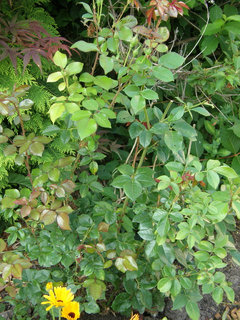
smithga31
8 years agolast modified: 8 years agoStrawChicago,
Farmers here spray with Epsom salts (magnesium and sulphur). I may try that this week. I did put a little in the soil amendment and (hopefully) antifungal mixture yesterday. Your roses are gorgeous and luxuriously healthy.
My small rose bed bloomed beautifully in its first bloom, then black spot took over. Your depletion theory sounds right. Hope my amendments and spray/dust/prune/clean up bed efforts work.
Thanks for all your input and great information.
strawchicago z5
8 years agolast modified: 8 years agoHi smithga: Thanks for the feedback in your garden. A rosarian once stated "dolomitic clay is best for Austin roses", and that's what I have: high in magnesium soil, and I'm next to a limestone quarry and mined gypsum plant. My soil pH is 7.7. Epsom salt is neutral pH. And the pH of vinegar is 2.2. For pH levels of various substances, see link below:
http://www.miamisci.org/ph/hhoh.html
The reason why Milk of Magnesia at pH 10.5 works so well for skin-fungal-infection is its HIGH pH, very alkaline. Milk of Magnesia is used as an anti-acid, and underarm deodorant. Calcium hydroxide at pH 12.4, the ingredient used in tap-water processing: this also has high pH. My water pH is 8.6, and when I store water in the basement, zero mold nor odor for 5 years. However, I have a bucket of kitchen water, I threw used lemons to LOWER the pH, down to rain water pH (5.6 to 6) .. and that bucket gets moldy within a few days !!
eHow summarizes the previous research-abstract which I quoted. See below:
http://www.ehow.com/facts_7691732_fungus-acidic-soil.html
"Threshold
- According to a 2009 study in the journal "Applied and Environmental Microbiology," fungal growth in soil seems to increase down to about pH 4.5, at which point the trend reverses and fungal growth decreases dramatically. Soils more acidic than this pH (4.5) are far less able to support fungal growth.
Relative Abundance
- In acidic soils, fungi tend to be more plentiful than bacteria. Fungi outcompete bacteria under these conditions primarily because many bacteria are ill-adapted to thrive in acidic soils; fungi have thicker cell walls and other physiological adaptations that help to protect them. Fungi also seem to be more plentiful in forest soils, which are often more acidic."
jim1961 / Central Pennsylvania / Zone 6
8 years agolast modified: 8 years agoI took out the mulch under my sisters rose bush so the soil will dry out... Cleaned up all the BS fallen leaves... Put alittle larger fencing around it so dog hopefully will not dig...
All in all my sisters rose bush still has enough leaves that it looks good...I'm sure it will re-leaf fast once it gets to rest from all that blooming...
We have received 7 inches of rain since May 31 and the weather has been cooler/ not much sun lately so all the ground under all our roses is wet even roses with bare soil...
All our roses have bare soil now except one Double Knockout... I pile all the mulch under him I take out of other locations because if our dog sees bare soil he digs...lol...So anywhere with bare soil I must fence or mulch to keep dog from digging or getting muddy...
I have a D Ko planted beside my sisters rose...(4ft away) I planted my sisters rose beside D. Ko because I knew that D. Ko would not get much Blackspot here no matter how much rain or how hard they bloom or whether the rose beside it has BS etc... I wanted a proven ironclad rose beside my sisters rose bush...
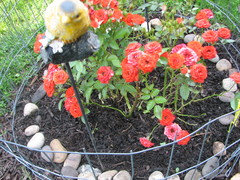
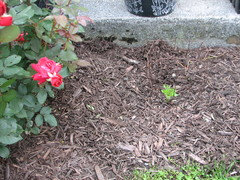

Pic from the other day...

strawchicago z5
8 years agolast modified: 8 years agoThank you, Jim, for posting those pics., your sister rose still look good with lots of blooms. As to what mineral deficiency contribute to black spots, look at the below link composed by Cornell University on boron deficiency, scroll ALL THE WAY down, and you'll see the chart where it lists what nutrients are deficient at what pH. Let's take pH 5.6 to 6, where rain-water pH falls, and where fungi thrives. At that pH level, you can see that calcium is somewhat deficient, magnesium is VERY deficient, manganese is EXTREMELY DEFICIENT, zinc and copper are VERY deficient, and boron is OK. The link states that high pH favors boron deficiency ... which is common in drought-stricken alkaline clay CA.
http://www.greenhouse.cornell.edu/crops/factsheets/boron_deficiency.pdf
msdorkgirl
8 years agoOhh pretty arrangement with the rocks ... Your sister's rose looks a little like my Kordana mini (purchased from HD). Mine used to be orange, but it's now a vibrant pink.
Generally though, roses of similar type and color are not very much different, are they? I'll attempt to do a picture breakdown like another post on this forum to help identify characteristics of the rose. Maybe that will help in getting an identity on yours.jim1961 / Central Pennsylvania / Zone 6
8 years agoThanks Straw,
But I'm not sure how to read that chart Straw... But our PH was 6.5-6.7... I will be sending my soil samples out soon...Probably beginning of next week...
Thanks msdorkgirl -Those rocks came from my sisters yard before her house was sold...
smithga31
8 years agolast modified: 8 years agoHas anyone tried the 'God Milk?' cure for black spot ? (1 part cow's milk to 1 part water sprayed liberally on the leaves) http://www.agardenforthehouse.com/2012/05/got-black-spot-get-milk/
My first ministrations (sulphur dust, and soil treatments as I described above) have not stopped the spread of black spot after a week. So I picked off infected leaves and branches and sprayed with the milk solution and spread corn meal, which is another alleged anti-fungal agent, around the plants. When the (remaining) leaves dried after being sprayed, they were shiny and pretty.
msdorkgirl
8 years agoI tried a nutritional drink (vanilla) because I reasoned there's a ton of good stuff for my body, why not the rose? I don't remember it being effective (and I think I was just being silly).
I really want to try the cornmeal thing to see about pretty and shiny leaves. I got that result from Marine Cuisine fertilizer (made my leaves really big though). Hope someone can help you. I am crossing my fingers myself since I haven't sprayed anything (organic or chemical) for blackspot in two weeks, so far so good.isak_light
8 years agoI have a rosa rugosa bush in which the leeaves f=grow a pale yellow. Some also get black eyeliner around the leaf edges. Bu the plant blooms. What causes the pale leaves and the black edging?
jim1961 / Central Pennsylvania / Zone 6
8 years agolast modified: 8 years agoisak_light, some simple things that could cause pale yellow leaves is those leaves are not getting enough sun so they yellow and drop. Or heat stress can cause leaves to yellow and drop... Water logged soil can...
Rugosa do not like anything sprayed on there leaves and can be fussy when to much fertilizer is applied to them... (Leaves can yellow....)
PH or nutrient problem in soil...
I learned this from my friend who grows a few Rugosas here close to me..
The black edging might be a key factor but I'm not sure what?
jim1961 / Central Pennsylvania / Zone 6
8 years agolast modified: 8 years agoRugosas adapted well to my friends acid clay soil here...His bushes gets a few yellow leaves here and there...But he does not fertilize it or spray its leaves with anything...
smithga31
8 years agolast modified: 8 years agoThanks, StrawChicago! I appreciate all your help.
Disclosure: This is my first attempt at growing roses with the exception of Fairy roses in a home foundation landscape and these are only three Apricot Drift rose bushes, not hybrid or fine antique or English roses.
This is zone 9 - north FL...however, the city to the North, Thomasville GA is known as the Rose City and our city has lovely rose gardens here and there.
My lot is an adverse situation in itself... a layer of poor topsoil over what was once a gravel clay parking lot over fill dirt in an area that was reclaimed lowlands (floodable, but not wetlands). This is also a very small lot in a senior citizen type neighborhood.
I have added many, many bags of amendments to the soil, dug deep, even pick axed through the clay to develop my planting beds. I have used a product called 'Aerify', a wetting agent with seaweed, etc. used to establish grass on golf courses, to increase percolation and help my grass grow roots through the gravel clay. Despite my efforts, this lot does not percolate like normal land. Rosemary won't grow here except in pots. I can't grow blueberries because the soil isn't acid, deep or porous enough.
I'm attempting to grow these lovely roses in the deepest soil on my lot and have dug deep, wide holes clear through the clay and made sure water would percolate. I added much good stuff when I refilled and planted. However, the roses may not get enough sun since my lot borders on the woods. I also need to water in the morning just before the sun hits the leaves since I can't switch to drip irrigation in my very small yard due to needing to water the other foundation plants. If the roses do not do well in this location, I may have to plant them out near the street away from the woods where they will get more sun.
strawchicago z5
8 years agolast modified: 8 years agoHi Smithga: I have 2 brothers and 2 sisters in Florida ... the soil varies even with one's own garden. Only 1/2 hour away, was my last house with acidic clay (more loamy & easy to dig) ... Rugosa did well. But now in my ALKALINE CLAY (rock hard & tough to dig) ... my neighbor's Rugosa behave like Isak's. Austin roses can take partial shade well, esp. the dark-red, yellow, and orange Austin. In contrast, hybrid teas bloom best in full-sun.
I like shopping at Meijers nursery since they have a shade-cloth above. Hybrid tea like Perfume Delight WAS NOT blooming (too much shade), but many-petals Kordes Laguna had tons of blooms. The more soft petals, the more shade it can take. The fewer petals, the more sun it needs. Perfume Delight has only 30 petals according to HMF, but Laguna has much more petals .. HMF count of 55 petals for Laguna is wrong (it's more than that). I used to have Charles Darwin, an Austin rose with 136 petals ... I planted that in full-sun and it was stingy.
jim1961 / Central Pennsylvania / Zone 6
8 years agolast modified: 8 years agoBest of luck with that Rugosa isak_light! Is it just a young plant?
strawchicago z5
8 years agolast modified: 8 years agoRegarding Isak_light's question of Rugosa: "Some also get black eyeliner around the leaf edges." I have it on my black-cherry tomato right now, after 2 weeks of non-stop rain. Black eyeliner is a fungal infection which occurs during wet period. I already put some lime around the tomato plant, raising the pH will kill the fungal spores. We used to have tons of mushroom growing in our lawn during late fall with constant rain. I fixed the problem permanently by picking up the mushroom-caps, dispose them. Then I sprinkled lime on the area. No more mushrooms growing in that area despite May & June constant rain.
Rugosa does well in SAND, but it's the WATER-LOGGED clay that Rugosa breaks out in eye-liner around the edge. I will dig up that tomato with (black-eyeliner on leaves' edge) to see if it's a drainage problem, also test for the pH of that spot. It's on a tall raised bed, so I don't think it's a drainage problem. Probably too much pine-bark (pH 4) in that hole, that made the leaves more acidic, more prone to fungal-infection. Acidic leaves become thinner, wilt more, and more susceptible to fungal infection.
jim1961 / Central Pennsylvania / Zone 6
8 years ago
Talked to my friend who grows 2 Rugosas in Clay soil he said some of his Rugosa leaves do get the blackliner during prolonged wet periods but all in all his Rugosas do ok...But they do get there share of yellow leaves too at his location...strawchicago z5
8 years agolast modified: 8 years agoThank you, Jim, for checking with your friend ... much appreciated. I just dug up my tomato wit blackliner on leaves' edges. It's the same tomato with white and orange fungus on the mulch, posted in the other thread. It's NOT a fungal-tomato-blight infection, since none of the nearby tomatoes have that problem. I have 2 identical Indigo tomatoes, only one is affected, and not the other, so it's NOT a fungal infection.
Upon digging that tomato up, THANK GOD I didn't put pine-barks (pH 4) in that hole ... otherwise it would be harder to fix. It rained non-stop for the past 3 days, the drainage there is excellent: What I found was big chunks of compact & dense clay, very alkaline. The roots were stunt, since it could not go through such dense clay. I had to soak the entire root in a bucket of acidic-rain-water, for that sticky-clay to dissolve.
Mulching with cocoa mulch was great: tons of earth worms in the planting hole. Since I don't want to hurt the earthworms with too much gypsum ... I put enough gypsum just to break up the clay at the bottom. I fluffed up the soil with lots of cracked corn, since worms like that. So the problem with that Indigo tomato is compact & very alkaline clay, rather than fungal infection. Also Rugosa rose is known as VERY disease resistant, no need to spray for black spots or any fungal infections.
msdorkgirl
8 years agoSo besides taking a hairdryer to my leaves, is there anything instant one would suggest after an evening of rain? I just re-read this thread and maybe I'll get Milk of Magnesia and spray 1/2 of one of the roses and the other half with whatever sulfur/copper thing I can find?
strawchicago z5
8 years agolast modified: 8 years agoGreat idea, Msgirl, please let me know how that work out: Dust lower leaves & base with lime powder, pH near 12
- Spray with diluted Milk of Magnesia, pH over 10, very alkaline & also a drying agent & good source of magnesium.
Both the above are milder and less caustic than vinegar and sulfur. We used to have tons of mushroom growing in our lawn during late fall with constant rain. I fixed the problem permanently by picking up the mushroom-caps, dispose them. Then I sprinkled lime on the area. No more mushrooms growing in that area despite this May & June constant rain.
strawchicago z5
8 years agolast modified: 8 years agoThere are many scientific papers on the antifungal properties of magnesium oxide. Milk of Magnesia is a hydrated form of magnesium oxide. There's a research entitled
Evaluation of the antifungal effect of magnesium oxide nanoparticles on
Fusarium oxysporum F. Sp. lycopersici, pathogenic agent of tomato
and the conclusion: "
there exists a direct correlation between the administered dosage and controlling effect such that the concentration of 2% had the greatest effect in both liquid and solid growth media. "
strawchicago z5
8 years agoI dug deeper and found another research, which compares the anti-fungal effect of calcium oxide (the hydrated form is used to treat tap water and raise tap water pH), Zinc oxide (that's the stuff in baby-diaper-rash ointment), and magnesium oxide (hydrated form is Milk of Magnesia). Both magnesium oxide and calcium oxide are better anti-fungal agents than zinc oxide, perhaps due to their higher pH. Here's the research:
" To evaluate antifungal activities of MgO, CaO and ZnO powders quantitatively by indirect conductimetric assay.
Methods and Results: Candida albicans NBRC1060, Saccharomyces cerevisiae NBRC1950, Aspergillus niger NBRC4067 and Rhizopus stolonifer NBRC4781 were used as test micro-organisms .... MgO and CaO powders exhibited the antimicrobial activities against all fungi used in this study and showed little differences between types of fungi. However, although ZnO powder inhibited fungal growth, the values of [I]100 were over 100 mg ml−1.
Conclusions: Although a common method for evaluating antifungal activity requires over 5–7 days, the indirect assay could provide a rapid and quantitative evaluation of antifungal activity within approx. 2 days, and MgO and CaO were found to have antifungal activities."
http://onlinelibrary.wiley.com/doi/10.1111/j.1365-2672.2004.02234.x/full
smithga31
8 years agolast modified: 8 years agoJust reporting back:
The black spot on my roses seems to be gone despite a LOT of recent rain, heat and humidity here in North FL.
Since I did so many things to fight the fungus, can't be sure which one/s did the job:
- cleaned out old mulch
- treated soil with lime, epsom salts, sulphur/calcium, garden dust, corn meal, diatomaceous earth, manure tea, and rose food.
- pruned off diseased canes and pinched off diseased leaves.
- put in new mulch
- sprayed foliage with 1:1 low fat milk and water mixture.
- sprayed foliage with safer soap for bugs
- dusted foliage with garden dust (sulphur, etc.)
Now the leaves are clear of black spot, but the roses are not blooming very much possibly due to location and/or the fact that they were pruned so heavily and late due to the black spot.
Thanks to all who 'listened' and gave such good in-depth advice out of your abundance of experience!
smithga31
8 years agoStrawChicago - Can you buy potassium silicate or the red lava rock (ground up?) at a garden or farm supply store? Thanks!
strawchicago z5
8 years agolast modified: 8 years agoHi Smithga: Potassium silicate is sold on Amazon quite expensive, and I already bought crushed red-lava-rock on Amazon for $10, it helped with blooming, but DOES NOT help with black spots on Carding Mill. I know exactly what I did wrong with Carding Mill: Since that location is near tree, I put tons of alfalfa-pellets in the planting hole, and when that decomposes, it GLUE UP with my clay, roots get waterlogged in that sticky-combo. I did the same to black-spot prone Pink Peace, when I dug that up, it's a big glob of clay glued-up with alfalfa pellets.
Spraying leaves is temporary solution. Permanent solution is to dig the rose up, and fix the soil to make it loamy & easier for water to drain off. What I did to Pink Peace was to throw the old sticky-gobs of clay elsewhere, put in fresh top soil mixed with FLUFFY compost, plus coarse sand, plus red-lava-rock for drainage. Gypsum or gritty lime can be added, depending on one's soil pH.
The cause of black spots start with the planting hole .. I notice when the soil is fluffy, it's easier for nutrients from above to reach down to roots. But when the soil is hardened, and when you water it ... water just floats over, rather than sink in ... those are the roses most susceptible to black spots.
Coarse sand is a fantastic separating-agent. I found loose spots, with sand-grains intact, where I poked holes and stuff sand in these "breathe holes" ... that's done more than a year ago. Breathe holes can really perk up roses, even without stuffing sand inside. Crimson Glory was next to a tree, the soil there is rock-hard, thanks to my mixing in peat-moss with clay. When I watered it, the water just floated over, rather than sinking in.
So I used my large shovel to dig a circle around it, I meant to dig the entire rose up to fix the hardened hole. But it rained on me, so I left it there .. a circular gap around the entire rose. It perked up right after that .. and bloomed, thanks to rain-water going through that circular gap. I use a bamboo stick, a dandelion digger (great for stabbing soil), a thick butter-knife, a long thick scoop, and my big shovel just to create gaps. Then I top it with 1/2 gallon of coarse sand. It works fantastic to loosen hardened clay.
A long term solution is to dig the rose up, and fluff up the clay with cracked-corn, coarse sand, and organic matter. Cracked-corn glues up with clay, it's the gypsum and sand that helps to separate organic matter from clay. When roots can't get rid of excess water, they are more prone to diseases. Fluffy & well-drained soil is the best solution to fungal diseases.
Coarse sand is a must for fixing compacted clay. I get tons of leaves in the fall ... they glue together in wet-sheaths, but if I layer sand between the leaves, they don't stick together. I posted in the other thread about the myth of sand plus clay makes brick. That's NOT true. Coarse sand is FANTASTIC to break up my high-magnesium sticky clay .. I dug up spots 15 years later, and it's stilly fluffy & loamy where I mixed in sand. IT DOES NOT GLUE up into concrete like peat moss, alfafa (both meal and pellets), or wood chips. Below is an excerpt from a link that clarifies the misconception that mixing sand with clay become concrete: FALSE !!
smithga31
8 years agoWow - Thanks again, strawchicago.
About sand and clay - someone had also told me sand and clay make bricks...and to put peat and compost in the soil to make it drain better.
I'll plan to dig in some sand and replant the roses this winter when they go dormant.
There's a lot to learn about roses - but the fragrance and the cool velvety touch of a rose petal is a taste of heaven...and well worth all the fuss.
jim1961 / Central Pennsylvania / Zone 6
8 years agoI put some Espoma Organic Garden Lime under my sisters rose today Straw. That soil under my sisters rose bush is already fluffy and drains real well so not sure what else I could do??? Any suggestions Straw?
Also the new leaves are really taking there good old time turning green???
Suppose to rain tonight and rain for the next day or so I'm going to have to cover my sisters rose since I already put down lime...
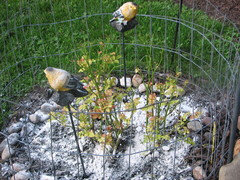
strawchicago z5
8 years agolast modified: 8 years agoHi Jim and Smithga31: Jim's picture looks good with dolomitic lime (both calcium and magnesium) as buffering agent. I would NOT cover that rose, since rain is needed to move that dolomitic lime to the root-zone. Calcium is needed to maintain health. The reason why roses lose leaves when there's too much rain: 1) poor drainage, and root can't cope with excess water 2) Soil is too acidic, there's no buffer against acidic rain.
Here's an excerpt from below link on the best buffer for acidic rain ... pH or rain is 5.6, perfect for fungal germination ... we need a buffer to counteract the acidity of rain.
"Various minerals in soil help to buffer against changes in pH when an acid or base is added. At high pH, calcium, magnesium and potassium oxides, together with carbonates, help to buffer pH changes; at acidic pH, aluminum oxides and iron hydroxides act as buffering agents; at intermediate pH levels, soil organic matter, mineral weathering and exchange reactions help to buffer the soil.
Function: A higher buffer capacity means that the soil can absorb more acid and/or base without a significant change in pH. In general, clay soils have higher buffer capacity than sandy soils, and a higher organic matter content tends to increase buffering capacity."http://acidrain2012.weebly.com/buffering-capacity-of-soil.html
**** From StrawChicago: Aluminum oxides is toxic to roots, but organic matter is safe. My alkaline clay (high in magnesium & calcium) is a good buffer against acidic rain. But MG potting soil (mostly peatmoss) is NOT a good buffer against rain. For Jim's loamy & well-drained soil, many layers of buffer on top is best. I would put more buffers on top (horse manure, alfalfa hay, or red-lava). Let the rain washes all those buffering agents down to the root zone. More buffering agents prevent the roots from soaking up the acidity of rain .. then leaves become acidic & thin out, and drop.
My most healthy rose has many layers of horse manure ON TOP (has organic matter, lime, plus many trace-elements). The hole with the most buffering agents: leaves, alfalfa hay, gypsum or lime .. produce the healthiest rose. It's NOT necessary to dig up a rose, with loamy soil, one can just pile up buffering agents on top. I dug my rose up since my clay glued up with FINE particles like peatmoss, pine fines, or alfalfa meal. Clay is fine-particle, it needs LARGE particles to prevent glue-up like COARSE SAND, large chunk pine bark, or large-strand alfalfa hay to create gaps, so roots can cope with excess water.
jim1961 / Central Pennsylvania / Zone 6
8 years agoDrainage is excellent under my sisters rose...But we do have a very high water table under ground here in certain areas...
The acid part certainly could be part of it from all our rain.
So I'll need to pile up some buffering agents on top and see what happens...
Thanks Straw!
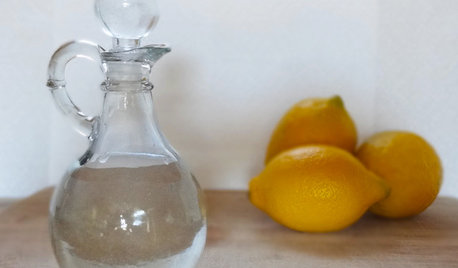

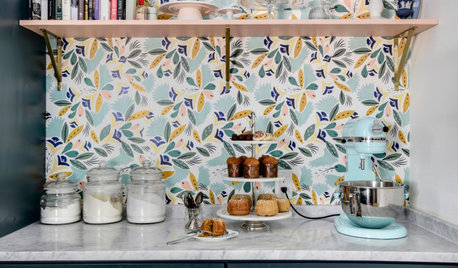




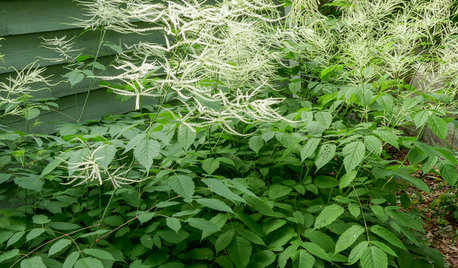

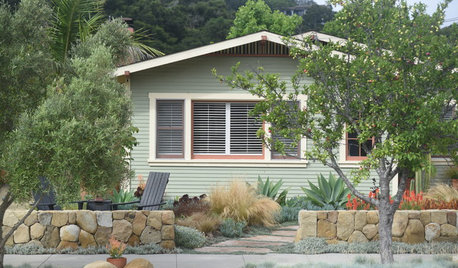






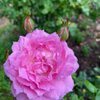
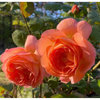
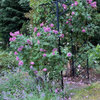
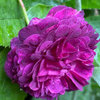
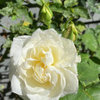
strawchicago z5